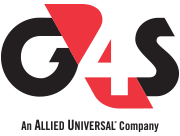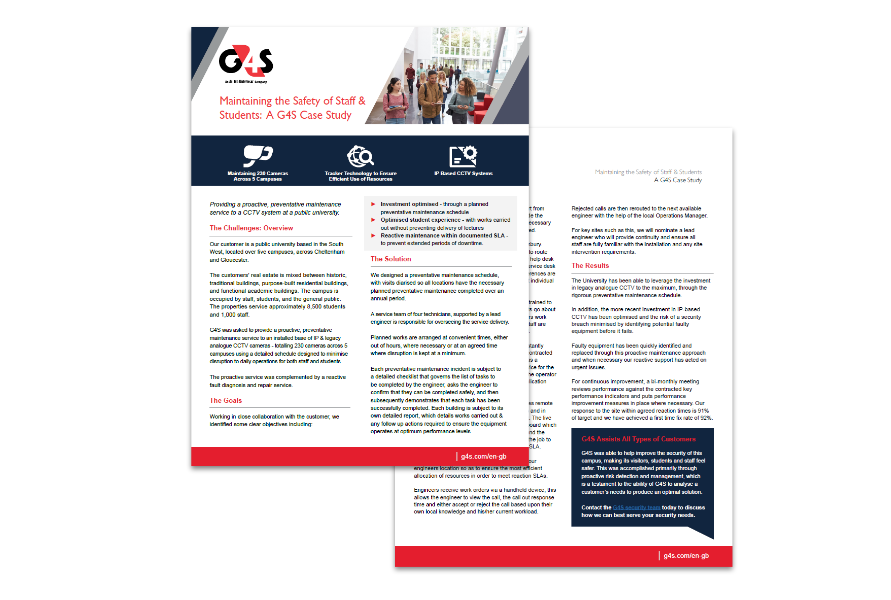Maintaining the Safety of Staff & Students

THE CHALLENGES: OVERVIEW
Our customer is a public university based in the South West, located over five campuses, across Cheltenham and Gloucester.
The customers’ real estate is mixed between historic, traditional buildings, purpose-built residential buildings, and functional academic buildings. The campus is occupied by staff, students, and the general public. The properties service approximately 8,500 students and 1,000 staff.
G4S was asked to provide a proactive, preventative maintenance service to an installed base of IP & legacy analogue CCTV cameras - totalling 230 cameras across 5 campuses using a detailed schedule designed to minimise disruption to daily operations for both staff and students. The proactive service was complemented by a reactive fault diagnosis and repair service.
THE GOALS
Working in close collaboration with the customer, we identified some clear objectives including:
- Investment optimised - through a planned preventative maintenance schedule.
- Optimised student experience - with works carried out without preventing delivery of lectures.
- Reactive maintenance within documented SLA - to prevent extended periods of downtime.
THE SOLUTION
We designed a preventative maintenance schedule, with visits diarised so all locations have the necessary planned preventative maintenance completed over an annual period.
A service team of four technicians, supported by a lead engineer is responsible for overseeing the service delivery. Planned works are arranged at convenient times, either out of hours, where necessary or at an agreed time where disruption is kept at a minimum.
Each preventative maintenance incident is subject to a detailed checklist that governs the list of tasks to be completed by the engineer, asks the engineer to confirm that they can be completed safely, and then subsequently demonstrates that each task has been successfully completed. Each building is subject to its own detailed report, which details works carried out & any follow up actions required to ensure the equipment operates at optimum performance levels. For our reactive service, we co-ordinate support from our Customer Service Centre (CSC) and provide the opportunity to log calls on a 24*7 basis when necessary for situations where urgent assistance is required. Service is coordinated from our base in Tewkesbury.
We made use of the latest Tesseract Software to route required visits in the most efficient manner. Our help desk teams work in collaboration with the in house service desk to make sure that each organisations ticket references are listed on each service incident. This means that individual cases can be easily reconciled by each party.
For site interventions, our field service team is trained to work unobtrusively whilst the building occupants go about their daily tasks. Training ensures that engineers work quietly, quickly, and efficiently. The University staff are able to contact the CSC via telephone or email. Upon receipt of a call, the call is logged and instantly appears on the live case log and displays the contracted response time. Within our CSC, each region has a nominated lead who provides continuity of service for the calling party’s help desk and makes sure that the operator fielding the call has the necessary site and application knowledge to field an appropriate response.
Where possible, the technical support team uses remote diagnostic tools in order to access the systems and in cases where it is possible, provide a remote fix. The live log instantly feeds into our ‘Unallocated Jobs’ board which includes a count-down timer for reaction time and the Service Co-Ordinator (Planner) then allocates the job to the best placed engineer within the contracted SLA.
We use TOM TOM tracker technology to track our engineers location so as to ensure the most efficient allocation of resources in order to meet reaction SLAs. Engineers receive work orders via a handheld device, this allows the engineer to view the call, the call out response time and either accept or reject the call based upon their own local knowledge and his/her current workload.
Rejected calls are then rerouted to the next available engineer with the help of the local Operations Manager. For key sites such as this, we will nominate a lead engineer who will provide continuity and ensure all staff are fully familiar with the installation and any site intervention requirements.
THE RESULTS
The University has been able to leverage the investment in legacy analogue CCTV to the maximum, through the rigorous preventative maintenance schedule. In addition, the more recent investment in IP-based CCTV has been optimised and the risk of a security breach minimised by identifying potential faulty equipment before it fails.
Faulty equipment has been quickly identified and replaced through this proactive maintenance approach and when necessary our reactive support has acted on urgent issues.
For continuous improvement, a bi-monthly meeting reviews performance against the contracted key performance indicators and puts performance improvement measures in place where necessary. Our response to the site within agreed reaction times is 91% of target and we have achieved a first time fix rate of 92%.
DOWNLOAD THE PDF CASE STUDY
If you would like this case study in PDF, please complete the form to gain access.

